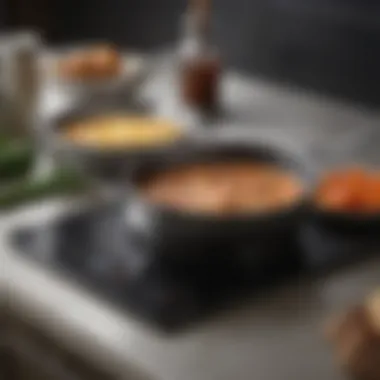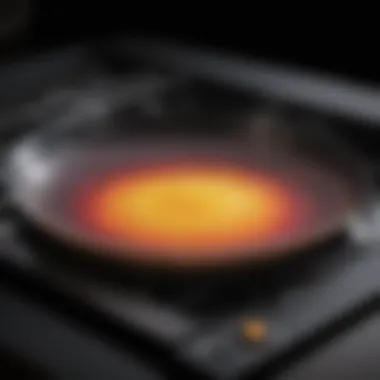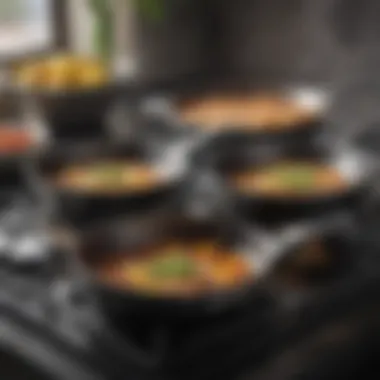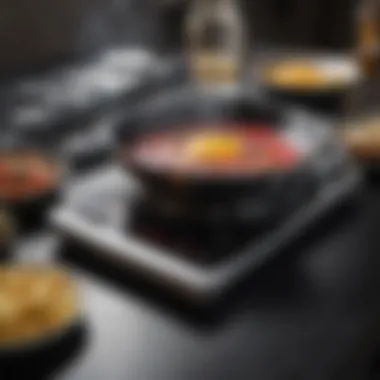Mastering Induction Cooking with a Twelve-Inch Pan


Intro
The world of cooking has seen significant advancements over the years, with induction cooktops emerging as a frontrunner for efficient and precise culinary experiences. For cooks who favor a twelve-inch pan, understanding the nuances of these cooktops can redefine their kitchen escapades. Despite their growing popularity, many people still have questions about their operation and how to make the most out of using specific cookware. This article will thoroughly explore induction cooktops, focusing on the advantages of using a twelve-inch pan, and offering guidance on everything from energy efficiency to maintenance.
Recipe Overview
Recipe Name
Cooking with Induction: Stir-Fry Perfection
Cuisine Type
Asian Fusion
Induction cooktops respond quickly to changes in temperature. When you place your twelve-inch pan on the surface, the cooktop generates heat directly in the pan instead of warming the surface beneath it. This unique functionality enables faster cooking times and regulated temperatures, which are crucial for dishes that rely on an exact touch.
"Cooking with an induction cooktop can feel like having the culinary skills of a master chef right at your fingertips."
Key Benefits of Using a Twelve-Inch Pan on Induction Cooktops
- Efficiency: Induction cooktops use about 90% of their energy for cooking, which is much higher compared to gas and electric burners. The extra size of a twelve-inch pan provides ample cooking space while optimizing energy use.
- Speed: The ability to quickly adjust the heat setting cuts down cooking time significantly—for someone on a tight schedule, this can be a game changer.
- Temperature Control: It allows for precise temperature adjustments, essential when cooking delicate dishes or those that can be easily ruined by excess heat.
Ingredients
While this is not a recipe in the traditional sense, knowing the right ingredients for a successful stir-fry cooked on an induction cooktop is essential. Here’s a brief rundown:
List of Ingredients with Measurements
- 1 lb chicken breast, sliced thinly
- 2 cups mixed vegetables (such as bell peppers, broccoli, and snap peas)
- 3 tablespoons soy sauce
- 1 tablespoon sesame oil
- 2 cloves garlic, minced
- 1-inch piece of ginger, grated
- 1 tablespoon cornstarch mixed with 2 tablespoons water (for thickening sauce)
Substitutions for Common Ingredients
- Chicken Breast: Can be replaced with tofu or shrimp for a different protein.
- Mixed Vegetables: Any fresh vegetables can work, like asparagus or carrots. Frozen vegetables can also serve as a quick alternative.
- Soy Sauce: Use tamari for a gluten-free option or coconut aminos for a lighter taste.
In cooking, the right pan and cooktop play pivotal roles in defining recipe outcomes. Mastering this combination—specifically with a twelve-inch pan—will enhance cooking experiences and elevate meal quality.
Preamble to Induction Cooktops
When it comes to modern cooking, induction cooktops have carved a niche unlike any other. Unlike traditional stoves that rely on open flames or electric coils, induction cooktops harness electromagnetic energy to directly heat the cookware. This not only promotes a rapid response to temperature adjustments but also offers remarkable energy efficiency. For folks looking to optimize their cooking experience, especially those in the culinary world, understanding induction cooktops is paramount.
Understanding Induction Cooking
Induction cooking relies on the fundamental principles of electromagnetism. When a compatible pan sits atop the cooktop, the cooktop generates a magnetic field that induces currents in the pan, producing instant heat. This means that the heat source is directly linked to the cookware; thus, the cooktop surface remains relatively cool, minimizing the risk of burns or fire hazards.
Not all pans, however, are suited for this kind of cooking. Metal that is ferrous, such as cast iron and certain stainless steels, works efficiently, while aluminum and glass do not. So, when you’re planning to use your favorite twelve-inch pan, check if it can play nice with induction technology. It’s worth noting that some manufacturers add a magnetic base to other materials to make them induction-compatible.
The Appeal of Induction Technology
One of the shining stars in the tale of induction cooktops is their impressive speed. They can bring water to a boil faster than gas or even traditional electric stovetops, making them ideal for those who have little patience when cooking. It’s like the tortoise and the hare, but in this case, the hare is the induction cooktop.


Additionally, these cooktops provide unparalleled temperature precision, allowing home chefs to dial in exactly what they need. Whether it’s a gentle simmer for a delicate sauce or a high sear for meats, these cooktops provide a level of control that many other methods can’t match. This precision is particularly beneficial when using a twelve-inch pan, as it allows for even heating and cooking consistency.
"Cooking on induction is not just about speed; it's about how you cook."
In addition to speed and precision, induction cooktops enhance kitchen safety. With no open flames or hot coils, the risk of accidental burns decreases significantly. Moreover, the cooktop heats only the pan, which means you're not wasting energy heating up the kitchen environment. In short, induction cooking is a trifecta of efficiency, safety, and speed, making it a worthy consideration for both cooking enthusiasts and everyday chefs alike.
In this section, we’ve only scratched the surface of what makes induction cooktops a revolutionary tool in the kitchen. For those who fancy themselves as culinary aficionados, understanding the core elements of induction technology can dramatically improve cooking experiences, especially when wielding that trusty twelve-inch pan.
The Twelve-Inch Pan: An Essential Kitchen Tool
A twelve-inch pan isn’t just another piece of cookware; it’s a fundamental tool that brings versatility and efficiency to the cooking experience. When discussing induction cooktops, the twelve-inch pan stands out for its perfect balance between size and usability. It allows for a variety of cooking techniques, from sautéing vegetables to searing meats, making it indispensable in a home kitchen.
The typical twelve-inch pan provides ample surface area, allowing cooks to prepare larger quantities without overcrowding. This is particularly beneficial when cooking for a family or entertaining guests. Moreover, its size allows for even heat distribution on an induction cooktop, which is crucial for achieving desired results efficiently.
Versatility of the Twelve-Inch Pan
What sets the twelve-inch pan apart is its versatility. With this one pan, it’s possible to fry, braise, simmer, and bake. Whether you are whipping up a quick stir-fry or a hearty ratatouille, the twelve-inch pan functions beautifully in a myriad of recipes. The larger cooking surface minimizes the need for multiple pots and pans, streamlining the cooking process.
Moreover, its compatibility with different heat sources — particularly induction — enhances its value. Because induction cooking relies on magnetic fields, the twelve-inch pan can quickly reach high temperatures, making it a great ally for chefs looking to achieve perfectly cooked dishes without delay.
Material Choices for Performance
The material of your twelve-inch pan plays a pivotal role in its cooking performance. Here, we delve into three popular materials used for these pans: stainless steel, cast iron, and non-stick coatings. Each offers its own distinct advantages and challenges, impacting everything from heat retention to maintenance.
Stainless Steel
Stainless steel pans are often seen as a staple in modern kitchens. Their ability to resist rust, stains, and corrosion makes them durable for everyday cooking. The key characteristic of stainless steel is that it does not react with acidic or alkaline foods, preserving the flavor of dishes. For induction cooking, this material is favored due to its excellent heat conduction properties.
However, it’s important to note that stainless steel can develop hot spots when not designed properly, making even heating a slight challenge. This is where its multi-layered construction comes into play, combining layers of aluminum or copper to enhance heat distribution.
Cast Iron
Cast iron is another material that has secured its place in many kitchens. Known for its heat retention and even distribution, cast iron pans are perfect for slow-cooking and frying. A standout feature of cast iron is its ability to develop a natural non-stick surface over time, enhancing the cooking experience. While heavy and often requiring more care in terms of seasoning, cast iron is prized for its durability and the unique flavor it can impart to foods. The downside, however, is its weight, which might not be ideal for all cooks.
Non-Stick Coatings
Non-stick coated pans offer a different approach to cooking. What makes them appealing is their ease of use; food releases effortlessly, simplifying cleanup. The non-stick surface requires less cooking fat, making it a healthier option. These pans can be great for delicate foods, like eggs or fish, that may otherwise stick. Nonetheless, the durability of non-stick coatings can be a concern, particularly when using high heat, which could potentially damage the surface. It’s also important to use utensils that won’t scratch the coating, further requiring some care in handling.
In summary, selecting the right twelve-inch pan depends heavily on both the cooking style and preferences of the user. Understanding the nuances of each material will empower cooks to optimize their culinary endeavors, especially when paired with the prowess of an induction cooktop. Being mindful of these options can lead to better meals and a more enjoyable cooking process.
Induction Cooktop Compatibility
When you're stepping into the world of induction cooking, understanding compatibility can't be understated. It's a crucial piece of the puzzle, especially if you're keen on maximizing the potential of your twelve-inch pan. Induction cooktops rely on magnetic connectivity, so knowing which cookware is suitable becomes important for efficiency and safety. Let’s have a closer look at what determines whether a pan or pot will play nice with induction technology.
Determining Compatible Cookware
Identifying Magnetic Properties
The essence of identifying magnetic properties in cookware largely revolves around its material composition. To put it simply, if a magnet sticks to the bottom of your pan, you're golden. This characteristic is fundamental because induction cooktops work by creating a magnetic field that directly heats the pan. So, materials like stainless steel and cast iron are the usual suspects when it comes to compatibility. However, not all stainless steel is created equal. Some products have a lower iron content, leading to weak magnetic properties and, consequently, poor performance.
The standout feature of magnetic-compatible cookware is its ability to transform magnetic energy into heat efficiently, achieving quick heating times. Yet, not all cookware will play along harmoniously. For example, aluminum and copper, which are prized for their excellent heat conduction, often need a magnetic base or disc to work on induction surfaces. This nuance makes understanding magnetic properties not just beneficial but essential for ensuring your cooking experience is seamless.


Cookware Structure Requirements
Next up is cookware structure requirements, another fundamental aspect that can make or break your experience with an induction cooktop. The cookware must have a flat, smooth bottom to establish a good contact with the induction surface. When there's a gap, the magnetic energy doesn't transfer effectively, and you might as well be cooking over an open flame.
The ideal characteristic of cookware that meets structure requirements is its weight and stability. Heavier pans often provide the best results as they sit flat and transfer heat evenly. However, there's a trade-off—heavier materials can be cumbersome to handle. Also, some pans come with a reinforcement layer that helps maintain that flat shape, even after years of cooking. It's important to recognize these unique features, for they can save you from frustrations in the kitchen, helping achieve better culinary results with ease.
Testing Your Cookware
Before diving headfirst into cooking, testing your cookware for induction compatibility can save you a world of trouble. A quick magnet test can validate if your chosen cookware is suitable. If the magnet stays stuck firmly, you've got a contender. If not, it’s time to reconsider your options.
Benefits of Using an Induction Cooktop with a Twelve-Inch Pan
The world of cooking has experienced quite a transformation with the advent of induction cooktops. They are not just a trend; they bring a slew of benefits that can enhance your culinary experience significantly, especially when paired with a twelve-inch pan. Let's delve into the specific perks you can expect by using this dynamic duo.
Energy Efficiency Keys
One of the standout features of induction cooktops is their energy efficiency.
- Direct Heat Transfer: Unlike traditional gas or electric stovetops that waste energy heating the air around them, induction cooktops transfer energy directly to the pan. This means that virtually all the energy generated is used for cooking, which can lead to quicker meal prep. That's a win for both time and utility bills.
- Lower Temperature Requirements: Induction heating provides rapid temperature adjustments. With a twelve-inch pan, you can achieve high heat for searing and then dial it back instantly for delicate sauces. This adaptability ensures that you aren't wasting energy by keeping the heat on when nothing is cooking.
- Eco-Friendly Cooking: With less energy consumed during cooking, induction cooktops associate well with sustainable kitchen practices. Whether you’re trying to reduce your carbon footprint or simply cut back on expenses, using a twelve-inch pan on an induction cooktop positions you as an eco-conscious chef.
"Cooking with induction can save nearly a third of the energy you would typically use on gas or electric cooktops."
Precision Heating Advantage
Precision is key when it comes to cooking, and induction cooktops deliver like no other method can.
- Consistent Temperature Control: Using a twelve-inch pan on an induction cooktop allows for an even distribution of heat. This precision means that your ingredients can cook uniformly, avoiding hot spots that can burn or undercook food. Having such control is especially beneficial for sauces or delicate items like fish.
- Instant Response Times: When you adjust the temperature, induction cooktops respond almost immediately. Stovetops that rely on residual heat can make it tricky to achieve the perfect cook on your steak. However, with an induction cooktop, you can lower the heat right as you sense things might be getting too hot, giving you greater control over the cooking process.
- Safe and User-Friendly: Beyond just benefits to the food itself, induction cooking is safer. The actual cooktop surface doesn’t get as hot, reducing the risk of burns while you’re maneuvering around your kitchen. This is especially important when you're managing multiple pots or pans at once.
These benefits undeniably contribute to an enhanced cooking experience. By harnessing energy-efficient practices and embracing precision, you can elevate your culinary endeavors like never before.
Whether you’re an amateur cook looking to learn or a seasoned chef honing your craft, the combination of a twelve-inch pan and an induction cooktop is an investment worth considering.
Techniques for Optimal Cooking
In the realm of modern culinary arts, mastering the techniques for optimal cooking is not just an added bonus; it’s a necessity, especially when it comes to using an induction cooktop with a twelve-inch pan. Proper techniques can significantly enhance flavor, texture, and overall cooking efficiency. Understanding how to adapt methods and make the most of the induction technology can contribute to a more fulfilling kitchen experience. A keen grasp of these techniques can directly influence the quality of the dishes prepared and lead to a more satisfying culinary journey.
Adapting Cooking Methods
Simmering to Searing
Navigating the cooking spectrum from simmering to searing represents a pivotal shift in culinary application. At its core, this technique relies heavily on temperature manipulation. Simmering is celebrated for gentle heat that coax flavors from ingredients, ideal for sauces or soups. Conversely, searing involves high heat aimed at developing a rich crust on meats or vegetables, an essential step for many recipes.
The key characteristic of this transition is its emphasis on moisture retention versus caramelization. Searing, for instance, creates a Maillard reaction. This not only enhances flavor but also locks in juices, yielding a juicy, tender outcome. Such a shift is beneficial for recipes aiming for depth and complexity.
However, while searing is appealing, it does require an understanding of timing. Too long on high heat can lead to bitterness, while too short might not develop the desired crust. Carefully monitoring the temperature settings on an induction cooktop can make a world of difference, aligning perfectly with the needs of the pan without unnecessary guesswork.
Utilizing Residual Heat
Residual heat is an often underappreciated yet immensely beneficial method in the kitchen. This technique takes advantage of the heat still lingering in the cookware after the cooktop is switched off. It’s a great way to finish cooking delicate items that need gentle temperatures, such as sauces or eggs, preserving their texture and flavor without the risk of overcooking.


The perhaps surprising advantage of utilizing residual heat lies in its energy efficiency; induction cooktops heat up quickly and can cool down just as rapidly. This characteristic means one can turn off the heat slightly before a dish is fully cooked, allowing the remaining warmth to complete the process. It’s a clever trick that reduces cooking time and energy consumption, ultimately making for a more eco-friendly approach to cooking.
Still, attention to detail is crucial when employing this method. If not carefully considered, residual heat might lead to overcooking rather than enhancing the dish. Thus, being attuned to how quickly your specific cooktop cools down is essential.
Understanding Temperature Settings
Proper comprehension of temperature settings on an induction cooktop can make or break your cooking endeavors. Each dish may call for a different approach, and knowing when to adjust the heat is key—an essential skill that can significantly elevate your meals.
Temperature settings allow cooks to customize the heat precisely according to the needs of the dish. For example, the first few minutes of a stir-fry may require a high setting to quickly seal in flavors, transitioning to a lower heat afterward to finish cooking without burning. This layered approach can vastly improve both presentation and taste.
Being savvy with your induction cooktop not only leads to better cooking outcomes but also fosters an overall smoother experience in the kitchen. Whether you're simmering sauces or searing steaks, tailoring your techniques will yield stunning results that are bound to impress.
Induction Cooktop Maintenance
Maintaining an induction cooktop isn't merely a chore; it's an essential part of ensuring its longevity and performance. Just like any sophisticated appliance, neglect can lead to diminished efficiency and potential breakdowns. This section elaborates on the importance of robust maintenance practices, delving into key cleaning protocols and addressing common issues that may arise during the use of twelve-inch pans.
Cleaning Protocols
Keeping your induction cooktop in top shape requires some intentionality with its cleaning. Here’s how to approach this task:
- Daily Wipe Down: After each use, it's wise to wipe down the surface of the cooktop with a soft, damp cloth. This helps remove spills or splatters before they have the chance to harden. Avoid using abrasive materials that could scratch the surface.
- Cleaning Solution: For tougher stains, a mixture of vinegar and water can work wonders. Spray it on the cool surface, let it sit for a few minutes, and then wipe clean with a microfiber cloth.
- Scraping Residue: If food residue gets baked on, a plastic scraper can be useful. Take care not to apply too much pressure to avoid damaging the glass.
"A little maintenance goes a long way; a clean cooktop enhances performance!"
- Periodical Deep Cleaning: Once in a while, give your cooktop a thorough cleaning. Utilize specialized cooktop cleaners to ensure no residues or coatings are left behind which might inhibit cooking performance.
- Ensure Dryness: After cleaning, ensure your cooktop is entirely dry before using it again. This helps prevent any unwanted interactions with the electric components underneath the surface.
Common Issues and Solutions
Induction cooktops are designed for efficiency, but like any machine, they can encounter their fair share of hiccups. Here’s a look at common issues along with practical solutions:
- Cookware Compatibility Issues:
- Unresponsive Controls:
- Inconsistent Heating:
- Overheating Indicator:
- Problem: Sometimes, using a twelve-inch pan that isn't induction-compatible can trigger alerts or simply not heat up.
- Solution: Regularly check the base of your pots and pans for a magnet test. If it sticks, you're good to go!
- Problem: When the touch controls become unresponsive, it can be frustrating.
- Solution: Ensure that the cooktop is clean, as grease or water can interfere with touch functionality. If problems persist, consult your manual or manufacturer.
- Problem: If the cooking temperature seems erratic, it might be problematic.
- Solution: Check that your cooktop is level. Uneven surfaces can lead to improper contact with cookware, which affects heating.
- Problem: The cooktop may shut off automatically, displaying an overheating message even when it's not too hot.
- Solution: This could feel like a sore spot. Try turning everything off for a short time and then restarting. If that doesn’t work, a technician may need to check the internal sensors.
Understanding these cleaning protocols and being aware of common problems prepares you for a smoother cooking experience with your induction cooktop. The more effort you invest in maintenance today, the better your cooking adventures will be tomorrow.
Epilogue
The insights presented in this article underscore the value of understanding induction cooktops when working with a twelve-inch pan. This optimal combination not only enhances cooking efficiency but also transforms the culinary experience into something inherently enjoyable.
Future of Induction Cooking
The future of induction cooking appears bright, with advancements likely to make it an even more essential choice for home cooks. The technology behind induction cooktops is continually evolving, paving the way for better energy efficiency and user-friendly designs. With innovations like smart cooking sensors and enhanced safety features, home chefs can expect a streamlined cooking process that maintains precision and consistency.
Moreover, as eco-friendliness becomes more of a consumer priority, induction cooktops shine with their ability to reduce heat waste. Unlike traditional cooking methods that lose a great deal of energy, induction cooking transfers heat directly to the pan, making it not only faster but also more sustainable.
"The shift toward induction technology signifies not just a trend but a deeper understanding of our cooking habits and the environment."
Final Thoughts
In wrapping up, it's worthwhile to reflect on how induction cooktops and a twelve-inch pan together represent a harmonious amalgamation of ease and effectiveness in cooking. Whether you are a casual home cook or a culinary enthusiast, using this setup empowers you with the control and efficiency needed to craft delightful dishes. Furthermore, by understanding maintenance practices and cooking techniques, individuals can extend the life of their cookware and maximize their cooking endeavors. As you delve deeper into the art of cooking with induction, you may find that this approach not only enhances flavor and texture but also simplifies the process in ways you might not have imagined.















